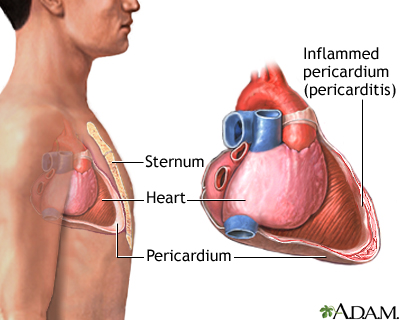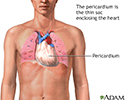Pericarditis
Pericarditis is a condition in which the sac-like covering around the heart (pericardium) becomes inflamed.
Causes
The cause of pericarditis is unknown or unproven in many cases. It mostly affects men ages 20 to 50 years.
Pericarditis is often the result of an infection such as:
- Viral infections that cause a chest cold or pneumonia
- Infections with bacteria (less common)
- Some fungal infections (rare)
The condition may be seen with diseases such as:
- Cancer (including leukemia)
-
Disorders in which the immune system attacks healthy body tissue by mistake
Disorders in which the immune system at...
An autoimmune disorder occurs when the body's immune system attacks and destroys healthy body tissue by mistake. There are more than 80 types of aut...
 ImageRead Article Now Book Mark Article
ImageRead Article Now Book Mark Article -
HIV infection and
AIDS
AIDS
Human immunodeficiency virus (HIV) is the virus that causes AIDS. When a person becomes infected with HIV, the virus attacks and weakens the immune ...
 ImageRead Article Now Book Mark Article
ImageRead Article Now Book Mark Article -
Underactive thyroid gland
Underactive thyroid gland
Hypothyroidism is a condition in which the thyroid gland does not make enough thyroid hormone. This condition is often called underactive thyroid....
 ImageRead Article Now Book Mark Article
ImageRead Article Now Book Mark Article -
Kidney failure
Kidney failure
Acute kidney failure is the rapid (less than 2 days) loss of your kidneys' ability to remove waste and help balance fluids and electrolytes in your b...
 ImageRead Article Now Book Mark Article
ImageRead Article Now Book Mark Article -
Rheumatic fever
Rheumatic fever
Rheumatic fever is a disease that may develop after an infection with group A streptococcus bacteria (such as strep throat or scarlet fever). It can...
Read Article Now Book Mark Article -
Tuberculosis
(TB)
Tuberculosis
Pulmonary tuberculosis (TB) is a contagious bacterial infection that involves the lungs. It may spread to other organs.
 ImageRead Article Now Book Mark Article
ImageRead Article Now Book Mark Article
Other causes include:
- Heart attack
- Heart surgery or trauma to the chest, esophagus, or heart
- Certain medicines, such as procainamide, hydralazine, phenytoin, isoniazid, and some drugs used to treat cancer or suppress the immune system
- Swelling or inflammation of the heart muscle
- Radiation therapy to the chest
Symptoms
Chest pain is almost always present. The pain:
- May be felt in the neck, shoulder, back, or abdomen
- Often increases with deep breathing and lying flat, and may increase with coughing and swallowing
- Can feel sharp and stabbing
- Is often relieved by sitting up and leaning or bending forward
You may have fever, chills, or sweating if the condition is caused by an infection.
Other symptoms may include:
-
Ankle, feet, and leg swelling
Ankle, feet, and leg swelling
Painless swelling of the feet and ankles is a common problem, especially among older people. Abnormal buildup of fluid in the ankles, feet, and legs ...
 ImageRead Article Now Book Mark Article
ImageRead Article Now Book Mark Article -
Anxiety
Anxiety
Stress is a feeling of emotional or physical tension. It can come from any event or thought that makes you feel frustrated, angry, or nervous. Stres...
 ImageRead Article Now Book Mark Article
ImageRead Article Now Book Mark Article -
Breathing difficulty when lying down
Breathing difficulty when lying down
Breathing difficulty while lying down is an abnormal condition in which a person must keep the head raised by sitting or standing to be able to breat...
 ImageRead Article Now Book Mark Article
ImageRead Article Now Book Mark Article -
Dry
cough
Cough
Coughing is an important way to keep your throat and airways clear. But too much coughing may mean you have a disease or disorder. Some coughs are d...
 ImageRead Article Now Book Mark Article
ImageRead Article Now Book Mark Article -
Fatigue
Fatigue
Fatigue is a feeling of weariness, tiredness, or lack of energy.
Read Article Now Book Mark Article
Exams and Tests
When listening to the heart with a stethoscope, the health care provider can hear a sound called a pericardial rub. The heart sounds may be muffled or distant. There may be other signs of excess fluid in the pericardium (pericardial effusion).
Heart sounds
A heart murmur is a blowing, whooshing, or rasping sound heard during a heartbeat. The sound is caused by turbulent (rough) blood flow through the h...

If the disorder is severe, there may be:
- Crackles in the lungs
- Decreased breath sounds
- Other signs of fluid in the space around the lungs
The following imaging tests may be done to check the heart and the tissue layer around it (pericardium):
-
Chest MRI scan
Chest MRI scan
A chest MRI (magnetic resonance imaging) scan is an imaging test that uses powerful magnetic fields and radio waves to create pictures of the chest (...
 ImageRead Article Now Book Mark Article
ImageRead Article Now Book Mark Article -
Chest x-ray
Chest x-ray
A chest x-ray is an x-ray of the chest, lungs, heart, large arteries, ribs, and diaphragm.
 ImageRead Article Now Book Mark Article
ImageRead Article Now Book Mark Article -
Echocardiogram
Echocardiogram
An echocardiogram is a test that uses sound waves to create pictures of the heart. The picture and information it produces is more detailed than a s...
 ImageRead Article Now Book Mark Article
ImageRead Article Now Book Mark Article -
Electrocardiogram
Electrocardiogram
An electrocardiogram (ECG) is a test that records the electrical activity of the heart.
 ImageRead Article Now Book Mark Article
ImageRead Article Now Book Mark Article -
Heart MRI
or heart
CT
scan
Heart MRI
Heart magnetic resonance imaging is an imaging method that uses powerful magnets and radio waves to create pictures of the heart. It does not use ra...
 ImageRead Article Now Book Mark Article
ImageRead Article Now Book Mark ArticleCT
A computed tomography (CT) scan is an imaging method that uses x-rays to create pictures of cross-sections of the body. Related tests include:Abdomin...
 ImageRead Article Now Book Mark Article
ImageRead Article Now Book Mark Article - Radionuclide scanning
To look for heart muscle damage, the provider may order a troponin I test. Other laboratory tests may include:
-
Antinuclear antibody
(ANA)
Antinuclear antibody
The antinuclear antibody panel is a blood test that looks at antinuclear antibodies (ANA). ANA are substances produced by the immune system that atta...
 ImageRead Article Now Book Mark Article
ImageRead Article Now Book Mark Article -
Blood culture
Blood culture
A blood culture is a laboratory test to check for bacteria or other germs in a blood sample.
Read Article Now Book Mark Article -
CBC
CBC
A complete blood count (CBC) test measures the following:The number of red blood cells (RBC count)The number of white blood cells (WBC count)The tota...
 ImageRead Article Now Book Mark Article
ImageRead Article Now Book Mark Article -
C-reactive protein
C-reactive protein
C-reactive protein (CRP) is produced by the liver. The level of CRP rises when there is inflammation throughout the body. It is one of a group of p...
 ImageRead Article Now Book Mark Article
ImageRead Article Now Book Mark Article -
Erythrocyte sedimentation rate (
ESR
)
ESR
ESR stands for erythrocyte sedimentation rate. It is commonly called a "sed rate. "It is a test that indirectly measures how much inflammation is in...
Read Article Now Book Mark Article - HIV test
- Rheumatoid factor
-
Tuberculin skin test
Tuberculin skin test
The PPD skin test is a method used to diagnose silent (latent) tuberculosis (TB) infection. PPD stands for purified protein derivative.
 ImageRead Article Now Book Mark Article
ImageRead Article Now Book Mark Article
Treatment
The cause of pericarditis should be identified, if possible.
High doses of nonsteroidal anti-inflammatory drugs (NSAIDs) such as ibuprofen are often given with a medicine called colchicine. These medicines will decrease your pain and reduce the swelling or inflammation in the sac around your heart.
If the cause of pericarditis is an infection:
- Antibiotics will be used for bacterial infections
- Antifungal medicines will be used for fungal pericarditis
Other medicines that may be used are:
- Corticosteroids such as prednisone (in some people)
- "Water pills" (diuretics) to remove excess fluid
If the buildup of fluid makes the heart function poorly, treatment may include:
- Draining the fluid from the sac. This procedure, called pericardiocentesis, may be done using an echocardiography-guided needle.
- Cutting a small hole (window) in the pericardium (subxiphoid pericardiotomy) to allow the infected fluid to drain into the abdominal cavity
Surgery called pericardiectomy may be needed if the pericarditis is long-lasting, comes back after treatment, or causes scarring or tightening of the tissue around the heart. The operation involves cutting or removing part of the pericardium.
Outlook (Prognosis)
Pericarditis can range from mild illness that gets better on its own, to a life-threatening condition. Fluid buildup around the heart and poor heart function can complicate the disorder.
The outcome is good if pericarditis is treated right away. Most people recover in 2 weeks to 3 months. However, pericarditis may come back. This is called recurrent, or chronic, if symptoms or episodes continue.
Scarring and thickening of the sac-like covering and the heart muscle may occur when the problem is severe. This is called constrictive pericarditis . It can cause long-term problems similar to those of heart failure.
Constrictive pericarditis
Constrictive pericarditis is long-term (chronic) inflammation of the sac-like covering of the heart (the pericardium) with thickening and scarring. ...

When to Contact a Medical Professional
Call your provider if you have symptoms of pericarditis. This disorder is not life threatening most of the time. However, it can be very dangerous if not treated.
Prevention
Many cases cannot be prevented.
References
Imazio M, Gaita F, LeWinter M. Evaluation and treatment of pericarditis: A systematic review. JAMA . 2015; 314(14):1498-1506. PMID: 26461998 www.ncbi.nlm.nih.gov/pubmed/26461998 .
LeWinter MM, Hopkins WE. Pericardial diseases. In: Mann DL, Zipes DP, Libby P, Bonow RO, Braunwald E, eds. Braunwald's Heart Disease: A Textbook of Cardiovascular Medicine . 10th ed. Philadelphia, PA: Elsevier Saunders; 2015:chap 71.
-
Pericardium - illustration
The pericardium is a thin double-layered sac which encloses the heart. Fluid is contained within the layers and lubricates the constantly rubbing surfaces.
Pericardium
illustration
-
Pericarditis - illustration
Pericarditis is a disorder caused by inflammation of the pericardium, the sac-like covering of the heart. Pericarditis can be caused by bacterial, fungal, or viral infections. It may also be a result of injury or trauma to the chest, esophagus, or heart. Pain occurs as a result of the inflamed pericardium rubbing against the heart.
Pericarditis
illustration
-
Pericardium - illustration
The pericardium is a thin double-layered sac which encloses the heart. Fluid is contained within the layers and lubricates the constantly rubbing surfaces.
Pericardium
illustration
-
Pericarditis - illustration
Pericarditis is a disorder caused by inflammation of the pericardium, the sac-like covering of the heart. Pericarditis can be caused by bacterial, fungal, or viral infections. It may also be a result of injury or trauma to the chest, esophagus, or heart. Pain occurs as a result of the inflamed pericardium rubbing against the heart.
Pericarditis
illustration
Review Date: 2/24/2016
Reviewed By: Michael A. Chen, MD, PhD, Associate Professor of Medicine, Division of Cardiology, Harborview Medical Center, University of Washington Medical School, Seattle, WA. Also reviewed by David Zieve, MD, MHA, Isla Ogilvie, PhD, and the A.D.A.M. Editorial team.



